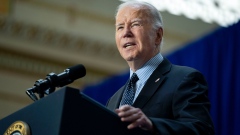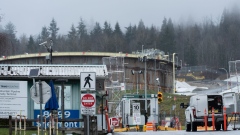Jan 9, 2020
More vigils to be held for Canadian victims of plane crash in Iran
The Canadian Press
Aftermath of Boeing plane crash near Tehran
A public outpouring of grief for the 176 victims of a plane crash on the outskirts of Tehran continued for a second day Thursday, with mourners across Canada planning candlelight vigils as more details of the devastating incident emerged.
Prime Minister Justin Trudeau has said 138 of the 176 passengers aboard the Kyiv-bound plane had a connecting flight to Canada, and the identities of the dead were slowly coming to light through relatives, friends and employers.
Some of those identified in the hours following the crash included newlyweds, families and university students.
The list of confirmed victims grew Thursday to include a Toronto bank manager and her husband, and a PhD student at a London, Ont., university.
In an email to staff, the Royal Bank of Canada said Parinaz Ghaderpanah, who managed a branch in north Toronto, and her husband Iman, a former RBC employee, had died in the crash.
The bank described Ghaderpanah as "a strong leader" and beloved co-worker, noting she had worked for the company for nine years.
The couple was also involved in a non-profit organization that promotes Iranian culture, the head of the organization said. Mehrdad Ariannejad, who runs the Tirgan organization, said the pair had returned to Iran to visit Parinaz Ghaderpanah's mother, who was recovering from surgery. They were scheduled to land in Toronto on Wednesday.
Hadis Hayatdavoudi, a student at Western University, was returning from a month-long visit with relatives in Iran — her first such trip since she moved to Canada in 2018 — when she died, her research supervisor said.
Jamie Noel said Hayatdavoudi was on flight 752 so she could be back in Canada in time to act as a teaching assistant for one of his courses.
"She found Canadians were very welcoming to her, coming from so far away, all by herself, a single woman in a strange country with a different language," Noel said, noting that she quickly found community with the other Iranian students in his lab.
The plane went down early Wednesday morning local time, several minutes after taking off from Iran's capital.
Vigils were scheduled Thursday evening on Parliament Hill, in Toronto's north end and in Halifax. Hundreds gathered across the country on Wednesday night to mourn in the bitter cold in Edmonton and Toronto.
Meanwhile, Iran has released an initial investigative report about the crash, which is among the deadliest air disasters involving Canadians.
The jetliner's crew were trying to turn back for the airport when the burning plane went down, the report says, noting that they never made a radio call for help.
"No radio communication indicating the unusual conditions was received from the pilot," the report says. In emergencies, pilots typically immediately contact air-traffic controllers.
Eyewitnesses, including the crew of another flight passing above it, described seeing the plane engulfed in flames before crashing, the document says.
The crash caused a massive explosion when the plane hit the ground, likely because the aircraft had been fully loaded with fuel for the flight to Ukraine's capital city.
"The gathered evidence at the crash site shows that impact point with the ground was a recreational park, and after the initial impact, other impacts were also observed, wrecking the aircraft fuselage spread across all the track at the accident site," the report says.
The document also says that both of the black boxes that contain data and cockpit communications from the plane have been recovered, though they sustained damage and some parts of their memory was lost.
The crash site track indicates that the aircraft was first approaching west to exit the airport boundary, but turned right following a technical problem, and had a track showing returning to the airport.
It also says that investigators have initially ruled out laser or electromagnetic interference as causing the crash.
In the report, Iran says it is inviting Canada and all of the other countries affected to participate in the investigation. Ukraine's government has said the plane was carrying 63 Canadians, 82 Iranians, 11 Ukrainian passengers and crew, 10 Swedes, four Afghans, three Germans and three Britons.
Under rules set out by the International Civil Aviation Organization, the countries where the crash happened, where the plane is registered, where the plane's operator is located, and where its manufacturer is based are all part of the investigation.
In this case, the Aircraft Accident Investigation Board of the Civil Aviation Organization of the Islamic Republic of Iran is in charge, while Ukraine will assist.
The secretary of Ukraine's Security Council told Ukrainian media that officials had several working theories regarding the crash, including a missile strike.
"A strike by a missile, possibly a Tor missile system, is among the main (theories), as information has surfaced on the internet about elements of a missile being found near the site of the crash," Oleksiy Danilov said. He did not elaborate on where he saw the information on the internet.
U.S. President Donald Trump suggested Thursday that he believes Iran was responsible for the crash, dismissing the country's initial claim that it was a mechanical issue.
"Somebody could have made a mistake on the other side," Trump said, noting the plane was flying in a "pretty rough neighbourhood."
Iran's military denied that a missile hit the airplane in a comment reported Wednesday by the semiofficial Fars news agency. He dismissed the allegation as "psychological warfare" by foreign-based Iranian opposition groups.
-- With files from The Associated Press









